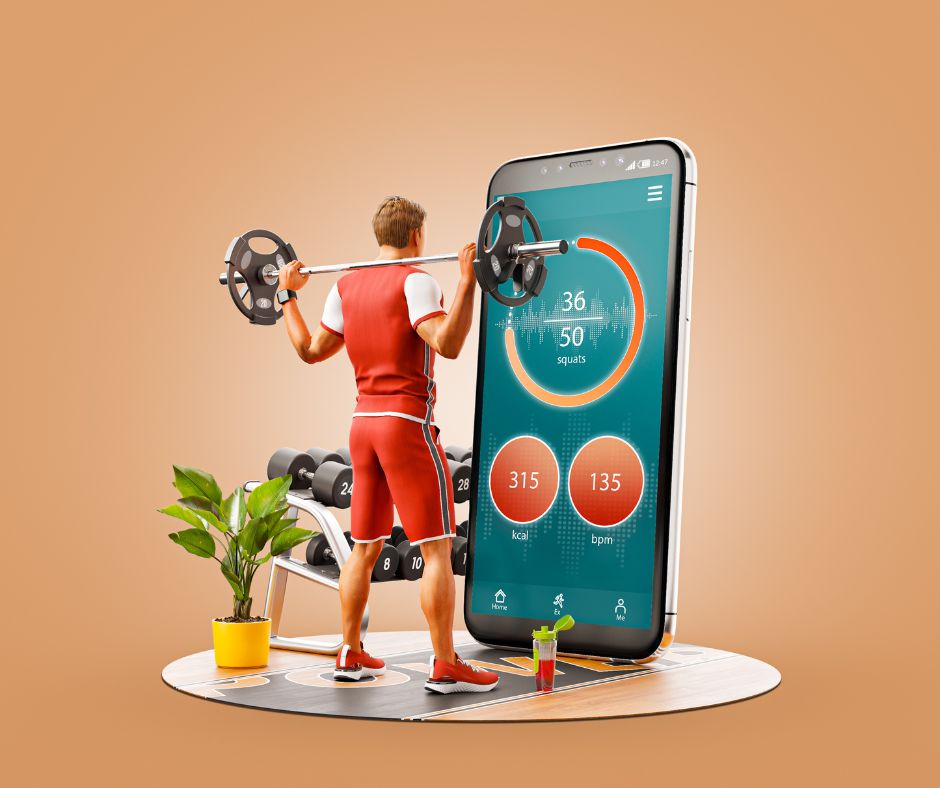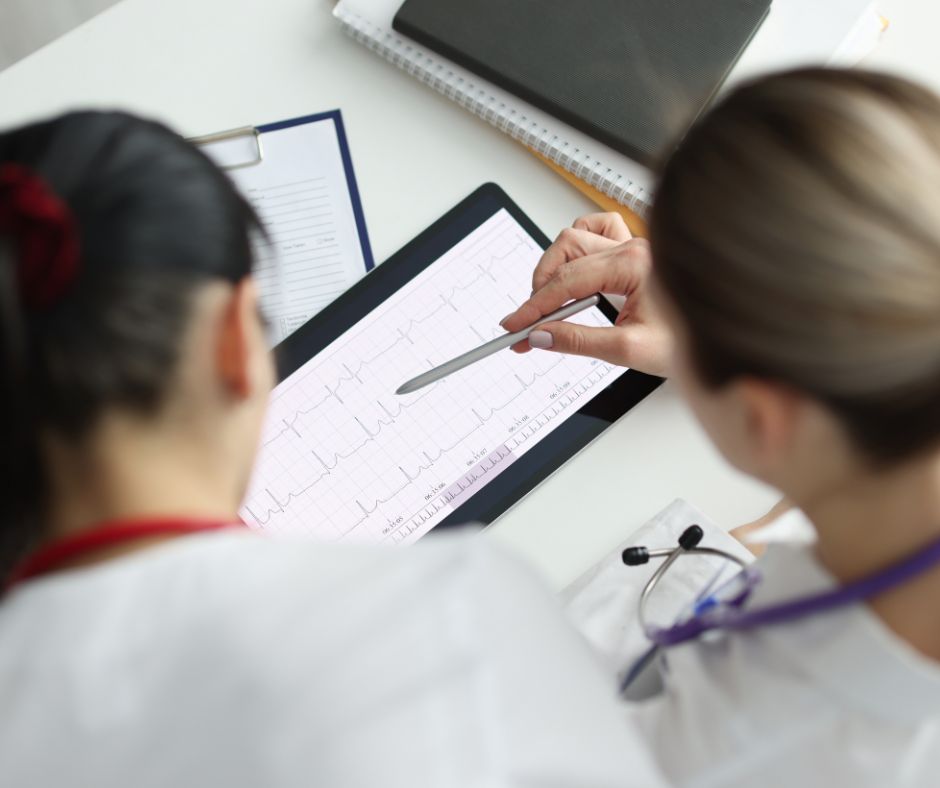Health apps have become powerful tools for preventive care and early disease detection. From tracking daily habits to advanced symptom checkers, these apps have made it much easier to manage our health, putting vital information and monitoring capabilities right at our fingertips.
Let’s see how these innovative health apps promote preventive care, empowering users to take proactive steps towards better health outcomes.
Contents
Preventive Care and App Usage

Health apps play a crucial role in preventive care by empowering people to take a proactive approach to manage their health. They include features to monitor vital signs, track fitness goals, and assess disease risks–all from the convenience of a smartphone.
Before we discuss how health apps promote preventive care, let’s define and review that concept.
What is preventive care?
Preventive care refers to routine healthcare services aimed at preventing illnesses and detecting health issues before they become serious. This includes regular check-ups, vaccinations, screenings, and lifestyle counseling.
Focusing on prevention can help people stay healthier, save money, and catch issues early when they’re more treatable. Preventing diseases is often easier and more cost-effective than treating them.
Growth of health app market in recent years
The health app market isn’t just growing; it’s booming. With over 300,000 health apps available and about 200 new ones released daily, we have a vast array of options available anytime.

As of 2023, there’s been over 200 million diet and nutrition app downloads, and 20% of Americans use wearable devices integrated with health and fitness apps. This growth is driven by increasing smartphone usage, rising awareness about health and fitness, and the convenience these apps offer.
The health app market has seen explosive growth in recent years. In fact, the global mHealth apps market size was estimated at USD 32.42 billion in 2023 and is anticipated to grow at a compound annual growth rate (CAGR) of 14.9% from 2024 to 2030.
This surge reflects a big shift in healthcare from reactive treatment to proactive prevention.
Key features of successful preventive care apps
What makes a preventive care app successful? The most effective apps share some common features:
- User-friendly interfaces
- Personalized health recommendations
- Integration with wearable devices
- Data visualization tools
- Social sharing capabilities
- Regular updates based on the latest health guidelines
These features help users stay engaged and motivated in their health journey.
App adoption rates and demographic trends

Who’s using these apps? While health apps appeal to a broad audience, certain demographic trends are emerging.
A study found that 84 million people in the U.S. used healthcare apps to monitor their health-related activities in 2022. Millennials and Gen Z lead the charge in health app adoption, with a particular focus on fitness and mental health apps.
Apps for Health Monitoring and Tracking
As health apps continue to grow in popularity, let’s explore some of the most popular categories and how they’re helping users monitor their health.
Apps to track vital signs

Vital sign tracking apps have become increasingly sophisticated. Many can now measure heart rate, blood pressure, and even blood oxygen levels using just a smartphone camera or with wearable devices.
For example, the Cardiio app uses a smartphone camera to measure heart rate with 97% accuracy compared to clinical pulse oximeters.
Apps to monitor sleep patterns and quality

Poor sleep can increase your risk of various health issues.
Sleep tracking apps help users understand their sleep patterns and quality. Apps like Sleep Cycle use your phone’s microphone and accelerometer to analyze your sleep stages and wake you up during your lightest sleep phase.
Apps for nutrition and diet tracking

Maintaining a healthy diet is crucial for preventive care. Nutrition apps like MyFitnessPal allow users to log their food intake, track calories, and monitor nutrient balance. These apps often include extensive food databases and barcode scanners for easy logging.
Physical activity and fitness monitoring
Fitness apps have come a long way from simple step counters. Apps like Strava or Nike Run Club can track various activities, provide workout plans, and even offer virtual coaching. Many integrate with wearable devices for more accurate data collection.

One study of older adults found that the Sit to Stand app can detect older adults with both frailty/pre-frailty and sarcopenia (Montemurro et al., 2024). The app was very accurate, with an 80-92% success rate. People the app identified with both frailty and sarcopenia were more likely to have other health problems like falls, hospitalization, depression, and low income.
Early Detection: Symptom Checkers and Risk Assessment Apps
One of the most exciting developments in health apps is their potential for early disease detection. Let’s look at how these apps are helping users identify potential health issues early.
Popular symptom checker apps and their accuracy
Symptom checker apps like Ada or WebMD Symptom Checker allow users to input their symptoms and receive potential diagnoses. While these apps shouldn’t replace professional medical advice, they can help users decide whether to seek medical attention.
A study of 22 symptom checker apps had low average diagnostic accuracy rates, highlighting the need for continued improvement in this area (Schmieding et al., 2022).
Risk assessment tools for common diseases
Many apps now offer risk assessment tools for common diseases like diabetes, heart disease, or certain cancers. These tools typically use questionnaires about lifestyle factors, family history, and sometimes integrate data from other health tracking features to provide a personalized risk assessment.

A UK study by Reid et al. (2024) looked at how well older adults could use a digital test for dementia risk and brain function. The test was easy for participants to complete.
Age affected all brain tests, while gender and education only impacted verbal skills. Women and those with more education did better on word-related tasks. Age was linked to lower scores on all tests, which matches what we know about aging and brain health, and could help spot early signs of brain decline.
AI-powered apps for skin cancer detection
Skin cancer detection apps are a prime example of how AI is enhancing early detection capabilities.

Apps like SkinVision use machine learning algorithms to analyze photos of skin lesions and provide a risk assessment. A study found that SkinVision had a 95.1% sensitivity in detecting malignant skin lesions (Smak Gregoor et al., 2023).
Mental health screening and mood tracking applications
Mental health apps are playing an increasingly important role in early detection of mental health issues. Apps like Moodfit or Daylio allow users to track their mood over time, potentially identifying patterns that could indicate underlying mental health concerns.
Integrating Health Apps with Healthcare Systems
The real power of health apps lies in their ability to integrate with broader healthcare systems. This integration is transforming how we interact with healthcare providers and manage our health data.
Apps that connect users with healthcare providers
Telehealth apps like Teladoc or Doctor On Demand allow users to consult with healthcare providers remotely. These apps have become particularly valuable during the COVID-19 pandemic, providing safe access to medical advice.
Electronic health record integration capabilities
Some health apps can now integrate with electronic health records (EHRs), allowing for seamless sharing of health data between patients and healthcare providers. This integration can lead to more informed medical decisions and better continuity of care.
Telehealth features in preventive care apps
Many preventive care apps now include telehealth features, allowing users to share their health data directly with healthcare providers and receive personalized advice. This integration of tracking and consultation features creates a more comprehensive health management experience.
Data sharing and privacy considerations
With the increasing amount of health data being collected and shared, privacy concerns are paramount.
Health apps must comply with regulations like HIPAA to protect user data. Users should always review an app’s privacy policy and understand how their data will be used and protected.
Conclusion
Health apps for preventive care and early detection are more than just trendy tools–they’re becoming essential allies in our quest for better health. Putting the power of prevention in our pockets, these apps can help users spot potential issues early, track important health metrics, and make informed decisions about their well-being.
While health apps are valuable, they should complement professional medical advice–not replace it. Don’t wait for a health problem to arise. Start exploring these apps, and take the first step towards a healthier, more proactive lifestyle.
References
8 Types of Preventive Care to Ensure Health Life for Seniors. (2022). EliteCare Health Centers. Retrieved from https://www.elitecarehc.com/blog/8-types-of-preventive-care-to-ensure-healthy-life-for-seniors/
Deb, T. (2024). Diet and Nutrition Apps Statistics 2024 By Tracking, Health and Wellness. Market.us Media. Retrieved from https://media.market.us/diet-and-nutrition-apps-statistics/
Deb, T. (2024). Home Gyms in Your Pocket: The Fitness App Market is on Fire, Reaching USD 4.9 Billion in 2023. Market.us Media. Retrieved from https://media.market.us/fitness-app-market-news/
Grand View Research. (2023). mHealth Apps Market Size, Share & Growth Report, 2030. Retrieved from https://www.grandviewresearch.com/industry-analysis/mhealth-app-market
Gupta, I. (2024). Trends in Telemedicine App Development 2024. iMark Infotech. Retrieved from https://www.imarkinfotech.com/trends-in-telemedicine-app-development-2024/
Jayani, P. (n.d.). The Ultimate Guide to EHR Integration for Mobile Health Apps. Blue Whale Apps. Retrieved from https://bluewhaleapps.com/blog/the-ultimate-guide-to-ehr-integration-for-mobile-health-apps
mHealth Apps Market Size | share and Trends 2024 to 2034. (2024). Precedence Research. Retrieved from https://www.precedenceresearch.com/mhealth-apps-market
Montemurro, A., Rodríguez-Juan, J. J., Martínez-García, M., & Ruiz-Cárdenas, J. D. (2024). Validity of a video-analysis-based app to detect prefrailty or frailty plus sarcopenia syndromes in community-dwelling older adults: Diagnostic accuracy study. DIGITAL HEALTH. doi.org/10.1177/20552076241232878
Reid, G., Vassilev, P., Irving, J., Ojakäär, T., Jacobson, L., Lawrence, E. G., Barnett, J. Tapparel, M., & Koychev, I. (2024). The usability and reliability of a smartphone application for monitoring future dementia risk in ageing UK adults. The British Journal of Psychiatry; 224(6):245-251. doi:10.1192/bjp.2024.18
Schmieding, M., Kopka, M., Schmidt, K., Schulz-Niethammer, S., Balzer, F., Feufel, M. (2022).
Triage Accuracy of Symptom Checker Apps: 5-Year Follow-up Evaluation. Journal of Medical Internet Research; 24(5):e31810, doi.org/10.2196/31810
Smak Gregoor, A. M., Sangers, T. E., Bakker, L. J., Hollestein, L., A., C., Nijsten, T., & Wakkee, M. (2023). An artificial intelligence based app for skin cancer detection evaluated in a population based setting. Npj Digital Medicine, 6(1), 1-8. doi.org/10.1038/s41746-023-00831-w
What is Preventive Care? (2018). ConnectiCare. Retrieved from https://www.connecticare.com/live-well/blog/wellness-and-prevention/whats-preventive-care


























